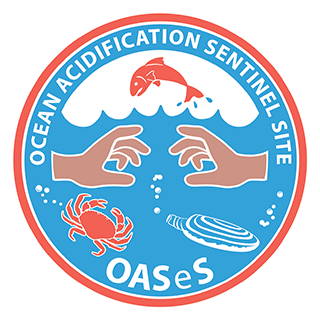What is the Problem?
The burning of fossil fuels and land use changes are increasing levels of carbon dioxide (CO2) in the atmosphere, roughly a quarter of which is absorbed by our global ocean. As a result, ocean chemistry is changing through a process called ocean acidification. Along the Olympic Coast, acidification and other climate-related changes, like marine heatwaves and hypoxia (low oxygen conditions), are increasing in frequency and severity. Marine species, and the human communities that depend on them, have been showing signs of stress, prompting coastal resource managers and stakeholders to take action.
Meeting the Challenge
Local, state, tribal, and federal representatives convened in 2016 to envision a collaborative approach to ocean change research, monitoring, and outreach in this region. The Office of National Marine Sanctuaries formally recognized the work of this partnership by designating Olympic Coast National Marine Sanctuary an Ocean Acidification Sentinel Site in 2019. The four coastal treaty tribes who are sustained by these waters — the Hoh Tribe, Makah Tribe, Quileute Tribe, and the Quinault Indian Nation — together with the state of Washington, resolved to support this designation for the Washington coast. A roundtable-style steering committee was formed to guide Sentinel Site activities and ensure broad representation of coastal resource manager and stakeholder interests.The Olympic Coast Ocean Acidification Sentinel Site (OASeS) was established to enhance coordination, collaboration, and communication around changing ocean conditions along the Olympic Coast.
What are Sentinel Sites?
Sentinel Sites are stations to keep watch; locations where coordinated observations and applied science by federal, tribal, state, academic, and community members enable early detection of ecosystem change in response to human or natural disturbance. Sentinel Site status promotes synergy by attracting, aligning, and amplifying capabilities for research, education, and outreach in order to raise awareness and inform our response to pressing environmental issues.
Why the Olympic Coast?
The four sovereign tribal nations of the Olympic Coast have stood sentinel over these waters since time immemorial and co-manage marine resources with state and federal managers. Their continued well-being depends upon access to healthy marine resources that the U.S. government is obligated by treaty to protect.
The distinctive physical, biological, cultural, and governance attributes and vulnerability to acidification and other CO2-related stressors make the Olympic Coast an excellent natural laboratory for studying ocean change and understanding its impacts on local communities. Its oceanographic influence on Puget Sound and coastal estuaries to the south underscore the ‘sentinel’ nature of these waters.
Ultimately, an improved ability to understand, forecast, and communicate the environmental and societal impacts of ocean change on the Washington coast can serve as a model for the broader Pacific Northwest and coastal regions around the world.

Image Credit: Center for Environmental Visualization, University of Washington, Washington Sea Grant, and NOAA Pacific Marine Environmental Laboratory
